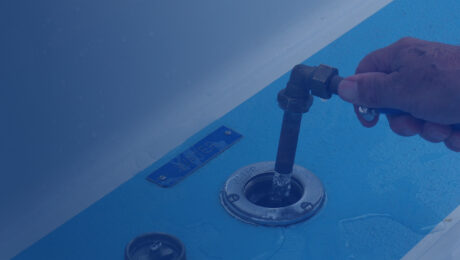Simply put, whether screaming across flat water to a favorite fishing hole or looking back at your kid grinning from ear to ear, their tube arcing over the wake astern as you bank the wheel to port, going fast in your motor boat is fun. In fact, getting out on the water and using your speed boat is hands down the best part of maintaining it. You are running your systems, sometimes testing their limits, and you are underway.
Boat owners are typically quite in tune with their boat and what is ‘normal’. While underway, you can look, listen, and feel how things are running. Back in port, any new information gathered will be important as you give time and attention to the everyday and routine aspects of speed boat maintenance. Everyday maintenance is the maintenance performed with each outing and routine maintenance is the maintenance required at various intervals to keep a boat ship shape.
The following is a Ship Shape Speedboat Maintenance Checklist:
Part 1: Everyday Maintenance
Speed boat owners may begin their day on the water with their feet on terra firma alongside their boat on a trailer or in a slip. If the boat is on a trailer, one should test the trailer lights, brakes, and tie-downs as safe passage to and from the water is of primary importance to maintaining a trailered vessel.
Before heading out on the water:
- Check Fluids
- Top up engine fuel, oil, and coolant (if applicable).
- Open fuel vent and pump fuel primer bulb (if applicable).
- Top up water tanks.
- Check Strainers or Screens
- Inboard motors have sea strainers while outboard motors have water intake screens at the base of the lower unit. Check strainer or screen for debris and keep clean.
- Check Lines
- Fuel lines should be secure and in good condition.
- No lines should be in the water at risk of getting entangled.
- Check Belts
- Inboard engines have belts. Check belts for proper tension.
- Check Pumps and Plugs
- Plugs keep water out. Put plugs in place before launching.
- Check that bilge pumps are on and working before heading out.
- Check Electronics
- Turn electronics on and test VHF.
- Check Battery
- Battery cables should be secure.
- Turn the battery on.
- Check Safety equipment
- Emergency alert devices (from flares to EPIRBS), First aid kit, personal medications and life jackets should be onboard, secure, and accessible.
- Fire extinguishers should be up-to-date and accessible.
- Make Trash and recycling receptacles at the ready to keep our waters clean and healthy.
- Check Flow
- On an outboard motor, the propeller must be in the water before starting the engine so that water can flow into the system properly and cool the engine as it runs.
- Upon starting any marine motor watch and listen for water to be expelled in rhythmic spurts from an inboard engine or a steady stream from the outboard engine.
Upon getting off the water:
- Bathtime- the most basic boat maintenance one can do
- Close fuel vent (if applicable).
- Remove and properly dispose of all trash and recycling from the smallest bits of debris or fishing line to the largest of packaging.
- Everything mariners can do to keep the waterways clean helps. Additionally, it is best to remove everything that can fester from one’s boat.
- Rinse using fresh water, dry, cover or stow electronics.
- Wash down all surfaces top to bottom and stem to stern. Whether on fresh or saltwater, boats are exposed to organic and inorganic elements that are best to be washed away at the end of the day. Remember to wash out bilges and remove debris.
- If the boat is equipped with fishing gear, wash all fishing gear: integrated rod holders, riggers, wells and/or coolers. Pay close attention to remove all fish parts and eliminate fish smell carefully and completely.
- If the boat has an interior space, wipe and dry all surfaces.
- If the boat is trailered, give the trailer a freshwater rinse as well. When rinsing, make sure to give extra attention to the wheels and brakes.
- Flush the engine
- Flushing freshwater through the engine is a good habit whether hauling out of fresh or salt water. This is particularly important when hauling a boat out of saltwater as saltwater left in the system is corrosive.
- Lubricate moving parts
- Open the engine and visually inspect moving parts. Wipe and lubricate as needed.
- Disconnect or turn off battery switch
- Dry and Store
- Boats and boat gear (including everything from pfd’s, to clothing, to canvas covers and sponges) must be stored dry in a covered or enclosed space to prevent mold and mildew from developing.
- When storing for a long period of time, consider draining the fuel tank and lines or adding a fuel stabilizer to the fuel tank
Part 2: Routine Maintenance
Many speed boat owners perform routine boat maintenance outside of their boating season - particularly if you aren't in California or Florida. This practice makes opening day smooth and ideally untroubled. It is best to check all your owner’s manuals for specific service suggestions and maintenance recommendations and requirements. Every boat part has a lifespan and generally knowing when it is customary to service or replace one’s parts can eliminate problems before they even start and/or fix inefficiencies that may be going unnoticed.
- Check regularly and adjust or change as needed:
- Examine Hull for bumps and bruises in the form of dents or cracks. Hull damage can start very small and lead to large problems if not noticed and repaired early.
- Belts and hoses: Check for proper tension and integrity. Visually inspect for cracks or kinks. Replace belts and hoses as needed.
- Wires and connections: Visually monitoring wires and connections is a good practice. As wires and connections need replacement consider rewiring so that wires and connections run above the waterline.
- Keep a bilge diaper under the engine to catch and monitor stray drips.
- Check Bilge pumps and water pumps for obstructions. Keep clear.
- Check Batteries. Monitor and clear of debris or corrosion.
- Check all mounted hardware and integrated fishing gear (if applicable). Monitor attachments. Keep clean, well lubricated, and tight.
- Check Electronics for updates. Navigational programs in particular release updates to charts frequently.
- Monitor fuel tank for water or condensation. Drain tank at the sign of any water.
- If the boat is trailered, check tire pressure and treads. Keep wheel bearings greased. Inspect wiring and connections, lines and tie-downs. Clean, Repair, or Replace as needed.
- Trailers also need their winch greased and their cable regularly examined.
- Safety Gear should always be topped up, easy to access, and stored properly. Regularly giving the boats’ safety gear attention takes a lot of stress out of emergencies.
- Check and Change annually, or every 100 hours, whichever comes first:
- Oil and oil filter (4-stroke outboards and inboard engines): Oil and oil filter/s should be changed to keep moving parts clean and their action smooth.
- Lower unit oil (outboards): When changing this oil, make a visual inspection of the seals and o-rings. These are important to monitor and change regularly to keep the lower unit watertight.
- Water Impeller: This important part of inboard and outboard engines circulates water to cool the engine while in use.
- Fuel filter: The fuel filter screens all fuel entering the engine system. Changing this filter keeps the screening process at its best and thereby the engine more efficient.
- If the boat is fiberglass an annual wax and polish keeps the speed boat looking ship shape.
- All exterior canvas covers, from cushions to electronics to entire boat covers benefit from annual cleaning. Remove, rinse, and soak in canvas cleaner. Pesky spots can be addressed with cleaner and a scrub brush. Note: some canvas cleaners like Mermaids and Simple Green are very concentrated and a little goes a long way. With the right amount of water, soap, and scrubbing, this washing will brighten canvas color and eliminate mold or mildew. Dry thoroughly.
- Stainless steel responds well to annual or bi-annual attention. Stainless steel specific products, like Barkeepers Friend, work great to eliminate rust spots and generally refresh the shine of stainless. In general, products that clean stainless steel are not products that should sit on fiberglass or woodwork. Target your efforts with cleaning products and wipe clean places they are not intended for.
- Check and change as needed or every 200-300 hours or annually, depending on usage:
- Spark Plugs: Annually clean and check gaps.
- Every 3-5 seasons
- If the boat is trailered, repack wheel bearings every 3 to 5 seasons.
- Consider total replacement of belts and hoses. Despite regular inspection, some wear and damage are difficult to see with the naked eye. Busted belts and burst hoses are among the number one reasons boats require a tow.
While some say, “Good things don’t come easy”, may this Ship Shape Checklist be to the contrary and help make good things be easy. For boaters, the good things on the water are supremely satisfying. Next time you are on the water enjoying your speedboat, take a little extra pleasure knowing that in addition to keeping your boat ship shape you are doing the very best thing you can do for your boat and quite possibly yourself: Using it.
Clearly, every item on this Checklist is within your control and yet, not everything that happens on or off the water is. Getting boat insurance with Ahoy! is for unpredictable, unplanned, and unwanted complications. Ahoy! is here as your backup and to give you peace of mind. When you need help to make good things and possibly the bad things be easy Ahoy! is here.


